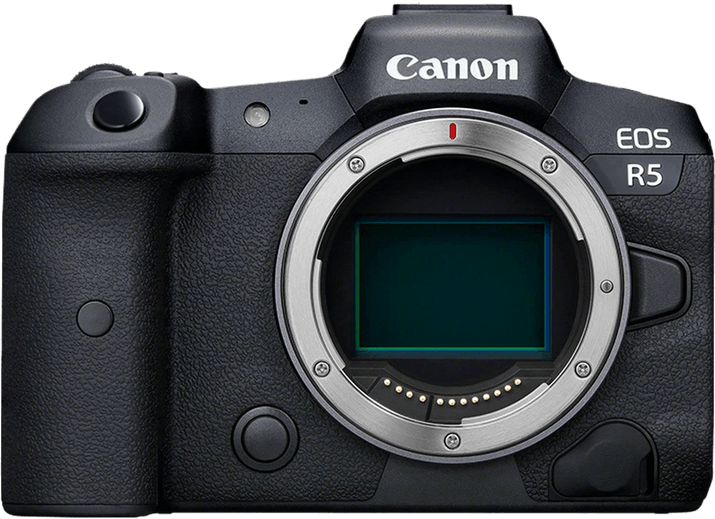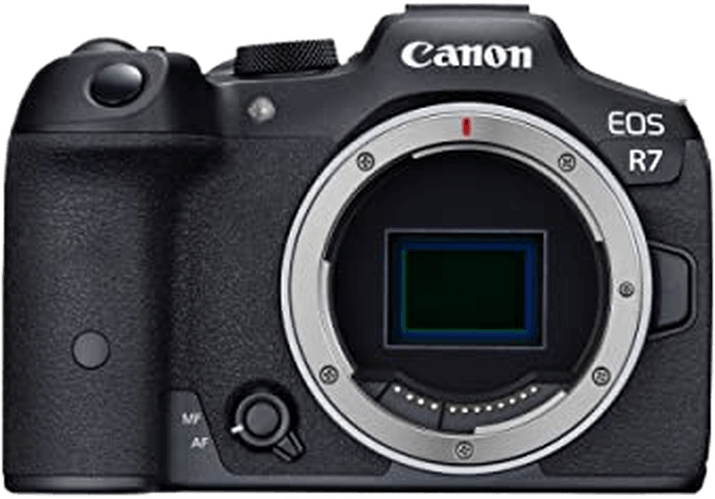Canon EOS R5 vs EOS R7 Comparison
Canon EOS R5

Canon EOS R7

The Canon EOS R5 outperforms the Canon EOS R7 with a score of 86/100 compared to the R7’s 83/100. Both cameras share similar features, such as being mirrorless and having a similar size and weight. The R5 measures 138 x 98 x 88mm and weighs 680g, while the R7 is slightly smaller and lighter at 132 x 90 x 92mm and 612g.
The R5 has a higher score due to its superior performance and features. Announced in 2020 with a launch price of $4499, it offers advanced capabilities for professional photographers. On the other hand, the R7, released in 2022 at a more affordable price of $1500, provides a budget-friendly option for those looking for a reliable camera without the need for high-end features.
Considering the specifications and scores, the Canon EOS R5 is the better choice for professionals seeking top-notch performance, while the Canon EOS R7 is a more budget-friendly option for casual photographers.
Canon EOS R5 vs EOS R7 Overview and Optics
The Canon EOS R5 outperforms the Canon EOS R7 in optics with a score of 88/100 compared to the R7’s 82/100. Both cameras share several specifications, including a CMOS sensor, Digic X processor, Canon RF lens mount, and image stabilization. However, there are key differences that contribute to the R5’s higher score.
The R5 has a 45-megapixel sensor, providing higher resolution images than the R7’s 33-megapixel sensor. This difference allows the R5 to capture more detail and produce larger prints. Additionally, the R5 has a shooting speed of 20 frames per second, compared to the R7’s 15 frames per second. This faster shooting speed enables the R5 to capture fast-moving subjects more effectively.
Furthermore, the R5 has a full-frame sensor, while the R7 has an APS-C sensor. The full-frame sensor offers better low-light performance and a shallower depth of field, resulting in more professional-looking images. However, the R7’s sensor has a higher DXOMARK score of 97, compared to the R5’s score of 95. This suggests that the R7’s sensor performs better in certain aspects, such as dynamic range and color depth.
Despite its lower score, the R7 has advantages in specific situations. The APS-C sensor provides a “crop factor,” which effectively increases the focal length of lenses, making it more suitable for wildlife or sports photography where extra reach is beneficial.
To conclude, the Canon EOS R5 is the superior camera in terms of optics, with higher resolution, faster shooting speed, and a full-frame sensor. However, the Canon EOS R7 may be a better choice for specific photography styles, thanks to its higher DXOMARK score and crop factor advantage.
Canon EOS R5 vs EOS R7 Video Performance
The Canon EOS R5 outperforms the Canon EOS R7 in video capabilities, with a video score of 100/100 compared to the R7’s 91/100. Both cameras share some common specifications, such as a maximum video frame rate of 120fps and built-in time-lapse functionality. However, the R5 surpasses the R7 in key areas, making it the superior choice for video.
The R5 has an impressive maximum video resolution of 8K, while the R7 only reaches 4K. This difference in resolution means the R5 can capture significantly more detail, resulting in higher quality video footage. Additionally, the R5’s maximum video dimensions are 8192 x 4320, compared to the R7’s 3840 x 2160. The larger dimensions allow the R5 to produce sharper and more detailed images, giving it an edge in video performance.
Despite the R7’s lower video score, it still offers excellent video capabilities. Its 4K resolution and 120fps frame rate enable it to capture high-quality footage suitable for most professional and personal uses. Furthermore, the R7’s built-in time-lapse functionality makes it a versatile choice for creative videography.
When comparing the Canon EOS R5 and R7, it is clear that the R5 is the better camera for video. Its higher resolution and larger dimensions contribute to its superior video performance, as evidenced by its perfect video score. While the R7 is still a strong contender with its 4K resolution and shared features, the R5’s exceptional capabilities make it the ideal choice for those seeking the best video quality.
Canon EOS R5 vs EOS R7 Features and Benefits
The Canon EOS R5 wins the features comparison with a score of 87/100, while the Canon EOS R7 scores 85/100. Both cameras share several specifications, such as having a touchscreen, flip screen, Wi-Fi, and Bluetooth. Neither camera has GPS.
The R5 surpasses the R7 in screen size and resolution. It has a larger 3.2-inch screen compared to the R7’s 3-inch screen, providing more space for composing and reviewing images. Additionally, the R5’s screen resolution is higher at 2,100,000 dots, compared to the R7’s 1,620,000 dots, which results in a sharper and clearer display.
The R7, despite having a slightly lower feature score, still offers competitive specifications. It matches the R5 in terms of touchscreen, flip screen, Wi-Fi, and Bluetooth capabilities, which are all essential for modern photography and connectivity. However, the R7 does not excel in any particular area compared to the R5.
Taking these differences into account, the Canon EOS R5 emerges as the superior camera in terms of features. Its larger screen size and higher resolution provide a better user experience, especially when composing and reviewing images. The R7, although not as feature-rich as the R5, still offers essential and competitive specifications that make it a viable option for photographers. Ultimately, the choice between these two cameras will depend on individual preferences and priorities, but the R5’s advantages in screen size and resolution make it the more desirable option for those who prioritize these features.
Canon EOS R5 vs EOS R7 Storage and Battery
The Canon EOS R7 outperforms the Canon EOS R5 in storage and battery with a score of 79/100, compared to the R5’s 68/100. Both cameras share common specifications, including two memory card slots, compatibility with SD/SDHC/SDXC (UHS-II) memory cards, the LP-E6NH battery type, and USB charging.
The EOS R7 excels with its impressive battery life of 660 shots, significantly more than the R5’s 320 shots. This advantage allows for extended shooting sessions without worrying about battery depletion. However, the R5 has an edge in storage versatility, accepting not only SD/SDHC/SDXC (UHS-II) cards but also CFexpress cards, which provides faster read and write speeds.
Considering these factors, the Canon EOS R7 is a better choice for those prioritizing longer battery life, while the Canon EOS R5 is more suitable for users who require high-speed storage options with CFexpress card compatibility.
Canon EOS R5 vs EOS R7 Alternatives
Still not ready to make a decision? Check out our other popular camera comparisons for inspiration:
